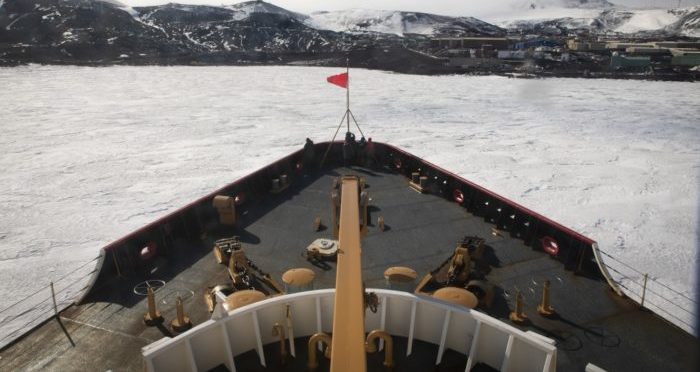The 159 crew members of the US Coast Guard Cutter Polar Star arrived on 22 January at McMurdo Station, following a 58-day transit from the US, marking its 23rd journey to Antarctica in support of Operation Deep Freeze. The cutter departed its homeport of Seattle on November 26.
Operation Deep Freeze is an annual joint military service mission to resupply the US Antarctic stations, in support of the National Science Foundation, the lead agency for the US Antarctic Program.
The 399-foot Polar Star arrived after creating a 23 mile channel through the ice to McMurdo Sound, which will enable the offload of over 19.5 million pounds of dry cargo and 7.6 million gallons of fuel from three logistic vessels.
Together these three ships carry enough fuel and critical supplies to sustain NSF operations throughout the year until Polar Star returns in 2021.
Each year, the Polar Star crew creates a navigable channel through seasonal and multi-year ice, sometimes as much as 21-feet thick, to allow refuel and resupply ships to reach McMurdo Station.
I am immensely proud of all the hard work and dedication the men and women of the Polar Star demonstrate each and every day. Maintaining and operating a 44-year-old ship in the harshest of environments takes months of planning and preparation, long workdays and missed holidays, birthdays and anniversaries with loved ones. The Polar Star crew truly embodies the ethos of the Antarctic explorers who came before us — courage, sacrifice and devotion,
… said Greg Stanclik, commanding officer of the Polar Star.
Commissioned in 1976, the Polar Star is the US’ only operational heavy icebreaker.
Reserved for Operation Deep Freeze each year, the ship spends the winter breaking ice near Antarctica, and when the mission is complete, returns to dry dock in order to conduct critical maintenance and repairs in preparation for the next Operation Deep Freeze mission. Last year, the cutter returned to Seattle on 11 March.
The Cutter Healy in the Arctic and the Cutter Polar Star near Antarctica are currently the only self rescue capabilities of the USCG.
The Coast Guard has been the sole provider of the nation’s polar icebreaking capability since 1965, and is seeking to increase its icebreaking fleet with six new polar security cutters to ensure continued national presence and access to the Polar Regions.
In April, USCG awarded VT Halter Marine of Pascagoula a contract for the design and construction of the Coast Guard’s lead polar security cutter, which will be homeported in Seattle.
The contract also includes options for the construction of two additional PSCs.
Replacing the Coast Guard’s icebreaker fleet is paramount. Our ability to clear a channel and allow for the resupply of the United States’ Antarctic stations is essential for continued national presence and influence on the continent,
…said Vice Adm. Linda Fagan, commander of the Coast Guard’s Pacific Area.






























































